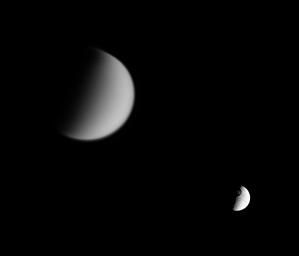
|
Tethys and Titan
- Click the image above for a larger view
- Full-Res JPEG (750 x 642) (8.8 kB)
- Full-Res TIFF (750 x 642) (482.2 kB)
Caption:
Cassini looks toward Tethys and its great crater Odysseus, while at the same time capturing veiled Titan in the distance (at left).
Titan (5,150 kilometers, or 3,200 miles across) is shrouded in a thick, smog-like atmosphere in which many small, potential impactors burn up before hitting the moon's surface. Crater-pocked Tethys (1,071 kilometers, or 665 miles across) has no such protective layer, although even a thick blanket of atmosphere would have done little good against the impactor that created Odysseus.
The eastern limb of Tethys is overexposed in this view.
The image was taken in visible light with the Cassini spacecraft narrow-angle camera on Jan. 6, 2006, at a distance of approximately 4 million kilometers (2.5 million miles) from Titan and 2.7 million kilometers (1.7 million miles) from Tethys. The image scale is 25 kilometers (16 miles) per pixel on Titan and 16 kilometers (10 miles) per pixel on Tethys.
Background Info:
The Cassini-Huygens mission is a cooperative project of NASA, the European Space Agency and the Italian Space Agency. The Jet Propulsion Laboratory, a division of the California Institute of Technology in Pasadena, manages the mission for NASA's Science Mission Directorate, Washington, D.C. The Cassini orbiter and its two onboard cameras were designed, developed and assembled at JPL. The imaging operations center is based at the Space Science Institute in Boulder, Colo.
For more information about the Cassini-Huygens mission visit http://saturn.jpl.nasa.gov/home/index.cfm . The Cassini imaging team homepage is at http://ciclops.org .
Cataloging Keywords:
| Name | Value | Additional Values |
|---|---|---|
| Target | Tethys | Titan |
| System | Saturn | |
| Target Type | Satellite | |
| Mission | Cassini-Huygens | |
| Instrument Host | Cassini Orbiter | |
| Host Type | Orbiter | |
| Instrument | Imaging Science Subsystem (ISS) | |
| Detector | Narrow Angle Camera | |
| Extra Keywords | Atmosphere, Crater, Grayscale, Impact, Visual | |
| Acquisition Date | ||
| Release Date | 2006-02-17 | |
| Date in Caption | 2006-01-06 | |
| Image Credit | NASA/JPL/Space Science Institute | |
| Source | photojournal.jpl.nasa.gov/catalog/PIA07705 | |
| Identifier | PIA07705 | |
